Second Look—With Callisto, Knizia Takes on Blokus
25 Mar
Posted by David Miller as Modern Board Games
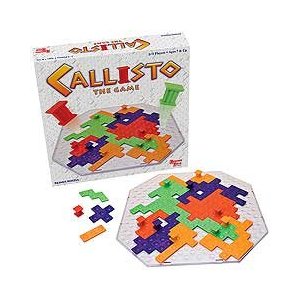 Callisto is a Reiner Knizia abstract-strategy design from University Games. Not to belittle Callisto. I’m glad University sent me one to review. I enjoy playing it. However, the similarity to Blokus is striking and I have no doubt that this game was published with the success of Blokus in mind. In fact, Callisto’s Rules sheet acknowledges the comparison, parenthetically cautioning players to place the game pieces “not corner to corner, but side touching side.”
Callisto is a Reiner Knizia abstract-strategy design from University Games. Not to belittle Callisto. I’m glad University sent me one to review. I enjoy playing it. However, the similarity to Blokus is striking and I have no doubt that this game was published with the success of Blokus in mind. In fact, Callisto’s Rules sheet acknowledges the comparison, parenthetically cautioning players to place the game pieces “not corner to corner, but side touching side.”
What then is different about Callisto? And what makes it a good game in its own right? The playing area is also a grid but on an octagonal board. The pieces are the same geometric shapes, though with some duplicates in each color. Pieces must be played touching another piece of the same color but side-to-side instead of corner-to-corner. The big difference is the pillars. Players use two pillars at the beginning of the game to mark starting spaces and hold one aside in case they get stuck later on. The great benefit of allowing players to choose their starting spaces instead of being stuck with a single corner is that the game plays just as well for two or three players as it does for four, which I don’t feel is true of Blokus.
I love that Callisto is an easy-to-learn and quick-playing game that nevertheless provides a fair amount of tension as you try to keep your pieces from being blocked in on multiple sides at once. When you just manage to protect your open space and use up all your shapes, that’s a satisfying feeling!
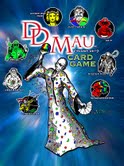 Purple Pawn writes about hundreds if not thousands of games each year, mostly after glancing at the box, rules, or press release. While you can’t judge a game solely by any of these, we think it’s fair (and our right) to post about what we think the game might be like or whether we have been enticed to play it after a first cursory look.
Purple Pawn writes about hundreds if not thousands of games each year, mostly after glancing at the box, rules, or press release. While you can’t judge a game solely by any of these, we think it’s fair (and our right) to post about what we think the game might be like or whether we have been enticed to play it after a first cursory look.
Steven Mcclain is not the first publisher or designer to write to us after one of these posts, upset that our post didn’t sing the praises of his game DD Mau properly, which we surely would do after playing the game. Steve got several of his early customers to pile on the comments in defense of his game, which I described as UNO+, i.e. something like UNO but with a bit more to it.
Funnily, that’s what all of the comments said, too, but they claimed that the “bit more” was light years more, on steroids more, not even a comparison more, and that it was unfair for me to malign the game without having played it. And how deep the game is, with all kinds of nifty plays. “Strategy like Chess” one commenter even wrote.
After some emails with me, Steve calmed down and turned out to be pretty cool. He send me a complementary copy of the game to review. I played a few games, with both three and five players.
Looking at the game a little more closely, the game still seemed a lot like UNO, with essentially the same cards, even many of the same special cards. It, like UNO, Taki, and other games are all derived from Crazy Eights and similar games. Some let you play more than one card at a time, some have different special power cards, but essentially a turn based matching/shedding game, of which Pagat lists several hundred.
It looked like the best chance the game had to excel above UNO and the like was an oddity it had about scoring: at the end of each round you gain negative points for the values on the cards you use to go out, and positive points for all the remaining cards left in your hands. Unlike most of the other games in this genre, this looked like it would provide a certain amount of tension about whether or not to hold on to higher valued cards. If you toss out the high cards, you won’t get many negative points if you go out. On the other hand, if you keep the high cards, you might get stuck with a high valued hand when someone else goes out.
Unfortunately, while this idea does play a very small part in the strategy of the game, it is too small to make any significant difference.
And that’s all of the good news.
DD Mau is not UNO+, it is, rather, UNO- (not a significant minus, but a minus nonetheless). There are many, many reasons for this.
First of all, although the cards are fine quality, the game comes in two boxes of cards with no paper rules. Rather than printed on paper as you would expect, the rules are printed on cards that take up half the deck of the second box. 112 cards: 80 playing cards, and 32 cards containing rules, FAQs, and power card summaries. I understand that printing requires 56 card blocks, so once the designer realized that his game had 80 he was in trouble. But this was not the best solution. Reading rules over 32 cards is a minor annoyance.
Playing cards and UNO cards have number on the corners for easy reading but also have big central numbers to help people with weaker eyesight. The non-power cards in DD Mau all have the same abstract picture of a paint-splatter of a man (no game or, seemingly, thematic purpose). Speaking of which, the game sure looks like it has some kind of theme having to do with magicians or criminals or something, but nothing in the rules or cards hints at any kind of theme, other then some mysterious pictures.
Secondly, the rules are not written all that well, which ups it to a mid-level annoyance. The rules, goals, and play are not presented, in my opinion, in a clear and organized fashion. To whit, just understanding how to play a few of the power cards required a series of clarifying emails with the designer.
Thirdly, I can’t blame the rules writer altogether, because the rules themselves are simply unnecessarily convoluted. Cards that seem simple in UNO (“Reverse”) require a paragraph of text to explain, partially because the writer can’t simply write “reverses play direction”, but also because each card has little niggling rules exceptions. For instance, the Reverse card, unlike the other power cards, requires the player who played it to play again. The Skip card can be combined with exactly one other of the penalty cards in a specific type of chain. There is a Take 2 card that skips the next player’s turn, and one that doesn’t. One can be played on any color, one only on the same color. Etc. etc. etc.
You have to pour over the exceptions with a fine-toothed comb. I’m reading them again now and still having trouble keeping them in my head. And the power card summary card is not any help with these exceptions.
This is the type of design you would expect to be caught and beaten out of a game by a good series of play-testing session. One commenter on my original post said “You can learn how to play UNO in ~5minutes; it takes HOURS to learn how to play DD MAU secondary to all of its complexities.” How right he is.
Fourth, even considering how convoluted and exception-prone all the power cards are, two of the cards are so convoluted and bizarre that I am still scratching my head over them. One is called Link Master, and it allows you to play a sequence of cards. In particular, unlike on most turns where you can play any number of cards of the same value as long as the first card played matches the color of the top card on the deck, if you play a Link Master you can play any number of cards of the same value (as usual), and then add a sequence of cards – only of the same color – starting with the last card of your set, and then top it off with any number of cards of the same value as the last card in your sequence. So you can play 4a 4b 5b 6b 7b 7c 7d. The sequence must be a minimum of three cards.
There is a joker power card called the Master Mau which allows you to simulate any other power card, and if you simulate a Link Master using a Master Mau, your sequence does not have to be of cards of the same color.
Furthermore, you cannot play a Link Master alone; it must be played together with another card.
Furthermore, there is a Deck Master card, a card that appears to have absolutely no game play value whatsoever, but which cannot be played unless you first play a Link Master. Unless you are going out, in which case you can play as many Deck Masters as you like without Link Masters, dumping them as you go out. What the heck is a Deck Master? The dealer is first determined by everyone drawing cards until one player draws a Deck Master. After a player goes out, the presence of a Deck Master in the sequence of cards used to go out, or in the hands of the players who are stuck with cards, determines who the next dealer is.
Why? Why bother with Deck Masters? Cut the cards to see who goes first and then make whomever goes out the next dealer. And Link Master: just say that it lets you play straights. Done.
For all this complication, in the games that I played, no one ever had more than around 6 or 7 cards in their hand, and so no one ever had a straight that could possibly have made use of the Link Master card, anyway. I briefly considered the possibility of purposely drawing cards in order to make use of a Link Master, but the chances of this doing you any actual good seemed quite remote.
Lastly, we come back to the scoring. The reason why my hopes were dashed about having some tension between holding or playing higher valued cards is that the game is, essentially, UNO. On the vast majority of your turns, you play the only card you can play, or you play the only card that makes any sense to play, and that’s all there is to it.
A game is scored until someone has over 505 points. After two hands in one of our games, the player in last had 120 points, so a game is going to take ten or more hands. If a player’s running score hits between 500 and 505 at the end of a hand (the rules say “In the event that a players [sic] score is 500, 501, 502, 503, 504, or 505, …”), the score is reduced to 400. And players can always score negative points. So the game is not actually guaranteed to end, ever.
To sum up, I see no reason that anyone should pick up this game rather than UNO. Which doesn’t mean that you can’t have a fun time playing it. Like many games, the fun is likely to depend more on the people you’re playing with.
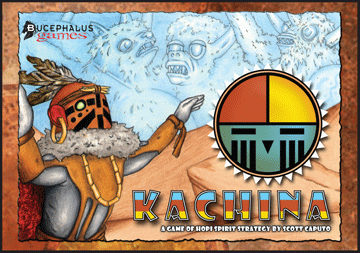 Kachina, from Bucephalus Games, is a deceptively simple game with a lot more to it than an initial reading of the rules would indicate. Placing numbered tiles one-at-a-time in crossword-like arrangements, players score points (one for each tile in the row or column) when the tile they place is the highest numbered in that column or row. Of the tiles (numbered 1 through 8), though, those with numbers 1 to 6 also have special powers. For example, when placed on the board, the value of the Wolf (number 4) is equal to the sum of all the Wolf tiles in the row or column. The Eagle (number 5) can be played on top of another tile already on the board, even covering one of a higher number. And the Hummingbird (number 2) dominates any row or column when in position at both ends.
Kachina, from Bucephalus Games, is a deceptively simple game with a lot more to it than an initial reading of the rules would indicate. Placing numbered tiles one-at-a-time in crossword-like arrangements, players score points (one for each tile in the row or column) when the tile they place is the highest numbered in that column or row. Of the tiles (numbered 1 through 8), though, those with numbers 1 to 6 also have special powers. For example, when placed on the board, the value of the Wolf (number 4) is equal to the sum of all the Wolf tiles in the row or column. The Eagle (number 5) can be played on top of another tile already on the board, even covering one of a higher number. And the Hummingbird (number 2) dominates any row or column when in position at both ends.
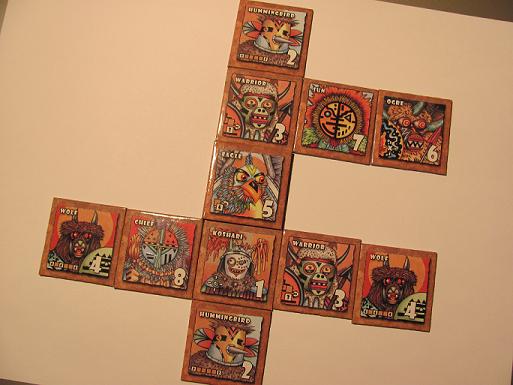
This combination, while pretty straightforward, can yield a very engaging experience. I started my first game expecting something quick and easy but ended up spending the next 45 minutes in a fair degree of concentration. It’s one of those games where you can get so involved in setting up your own moves, that you neglect to notice killer moves set up by your opponents. I’m ready to play some more!
I do have one small complaint, and that is with one part of the game’s components. On the one hand, the tiles are solid, with nice artwork, and the game comes with thick cardboard reference cards to remind players of each tile’s special powers. On the other hand, the pieces used for keeping score are a little difficult to track visually. The colors on the scoring markers don’t stand out very well, and the score board has a number-track lined-up in such a way that it’s difficult to read. Still, I wouldn’t consider this a major issue and it’s easy to work around. Also, Bucephalus has told me that they recognize the problem and already have plans to correct it in the next printing.
While Kachina is clearly an abstract strategy game, I also very much appreciated Bucephalus’ choice for the little theme that is there. The company could easily have gone with something standard, like medieval knights. Instead, the game is about Hopi spirits and the power struggles among them. I doubt you’ll find that subject matter already covered by another game on your shelf.
A copy of Kachina was provided to me for free by Bucephalus Games.
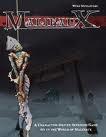 I have something to admit. I’ve been cheating on Warhammer 40K. Y’see, secretly, I like smaller games. I yearn for integrated game turns, deep mechanics and a style of play where every miniature is a tiny force of nature and not a speed bump. In short, I’ve met someone new and her name is Malifaux.
I have something to admit. I’ve been cheating on Warhammer 40K. Y’see, secretly, I like smaller games. I yearn for integrated game turns, deep mechanics and a style of play where every miniature is a tiny force of nature and not a speed bump. In short, I’ve met someone new and her name is Malifaux.
Malifaux is a relatively new miniature game from Wyrd Miniatures (originating from their line of off the wall miniatures) that is best described as a Victorian-western-gothic-steampunk-fantasy skirmish game – yeah, you read that right. Essentially, a big magical rift opens up in the 1800’s to a town in another dimension where they discover gems capable of amplifying magical prowess. The game has five factions, each with three “masters” (leaders) who control a force of 4 or more other figures (the game can play with larger groups of miniatures, but it’s not generally considered a good idea):
- Guild – the law & order in the town of Malifaux, these guys have some awesome abilities to mess with the other factions
- Resurrectionists – depraved necromancers whose numbers never seem to dwindle
- Arcanists – hard-core magic users who operate outside the bounds of the law and control elemental forces
- Neverborn – demons and nightmares native to Malifaux’s realm with savage combat capabilities
- Outcasts – ragtag survivors with their own agenda and motivations, with unique and bizarre abilities
 Malifaux uses an integrated (or shared) turn where players activate a single miniature at a time, making for some intense back and forth. The rules themselves are clear and clean and really show the best combination of modern rule sets like AT-43, Warmachine and Infinity. The mechanics to the game are super-simple and use an innovative card-flipping mechanic that uses both the value and the suit of the card to determine effects.Each miniature has unique abilities that create real change on the battlefield. The tradeoff is that you won’t want to play with too many miniatures lest you become overwhelmed with options (I personally think this is great as it helps to enforce the skirmish-level nature of the game).
Malifaux uses an integrated (or shared) turn where players activate a single miniature at a time, making for some intense back and forth. The rules themselves are clear and clean and really show the best combination of modern rule sets like AT-43, Warmachine and Infinity. The mechanics to the game are super-simple and use an innovative card-flipping mechanic that uses both the value and the suit of the card to determine effects.Each miniature has unique abilities that create real change on the battlefield. The tradeoff is that you won’t want to play with too many miniatures lest you become overwhelmed with options (I personally think this is great as it helps to enforce the skirmish-level nature of the game).
As for the miniatures themselves, these things are gorgeous. Amazingly detailed sculpts that are generous to the newbie (lots of detail that makes drybrushing super effective) and reward the expert. And these miniatures really run the gamut in terms of topics: evil nurses, demon children, zombie hookers and massive ice golems are just a few of the innovative sculpts in the initial line of minis.
You may be thinking, “that sounds great, but I really don’t have a ton of cash to spend on every minis game that comes out.” In my mind, the price is one of the things that makes this game such a no-brainer – a full starting force for a faction is ~$35 US. I don’t mean a minimal force that isn’t balanced (I’m looking at you Privateer Press...), I mean a full force that is designed to be balanced and ready to compete for a price that’s less than most Games Workshop plastic kits. Throw in a rulebook for $35 US and your entry to the game is probably a touch under $70US (throw in a second faction and you’re at $100 for a fully playable force). If you get a chance, this is one you don’t want to pass up.

 Last time we encountered this game it wasn’t under the best of circumstances. However, I had an opportunity to play a quick game of Tri-Cross at Games for Competitors’ Toy Fair booth, so I thought I’d update you on what I found.
Last time we encountered this game it wasn’t under the best of circumstances. However, I had an opportunity to play a quick game of Tri-Cross at Games for Competitors’ Toy Fair booth, so I thought I’d update you on what I found.
To be honest, I wasn’t wowed by the game but I did find it to be a decent abstract strategy title that I’d be happy to play again. The design of Tri-Cross isn’t exactly revolutionary. The game board is a cross-shaped grid, opposing players jump each others’ pieces, and the goal is to occupy the center space for four consecutive turns. (It reminds me of the puzzle-toy Hi-Q.) Added to this familiar mix, though, are two additional factors. First, each player has six pieces, essentially numbered one through six. Higher numbered pieces jump lower numbered pieces, except that the one jumps the six. Second, an adjacent piece must jump if it can. Okay, still nothing you haven’t seen somewhere before, yet all together it works pretty well. When playing, keeping an eye out for those mandatory jumps is essential. Chain reactions of jumping can happen and sacrificing a piece to pull an opponent out of the center is going to be an obvious strategy.
Instructional videos can be found on YouTube. Tri-Cross can accommodate two, three, or four players. Variant rules allow players to hide the strength of their pieces (by placing them face down) or to put them in fixed or random starting positions. Also, the game is available with the standard board, an eco-friendly cloth board, or a high-end one made from wood.
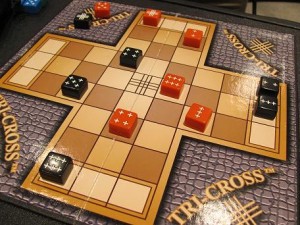
- Comments Off on Second Look—Tri-Cross
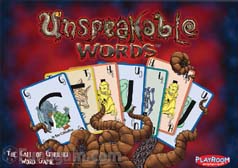 When Playroom Entertainment offered me a review copy of Unspeakable Words, I couldn’t resist the little purple Cthulhu pawns. You may not be so lucky as some copies of the game have them in green or black. But otherwise, I highly recommend this simple word game with a sinister twist.
When Playroom Entertainment offered me a review copy of Unspeakable Words, I couldn’t resist the little purple Cthulhu pawns. You may not be so lucky as some copies of the game have them in green or black. But otherwise, I highly recommend this simple word game with a sinister twist.
Unspeakable Words consists of a deck of letter cards, a 20-sided die, and a set of Great Old One miniatures. Each player receives a hand of cards and must spell a word with the letters on those cards. Every letter is worth a certain number of points. Higher point words are better, of course, but also risk a player’s sanity, represented by the plastic Cthulhus. After spelling a word, a player must roll equal to or greater than the point value of their word; if not, giving up one pawn. When a player has lost all five pawns, that player has gone insane and is out of the game. The first person to 100 points wins.
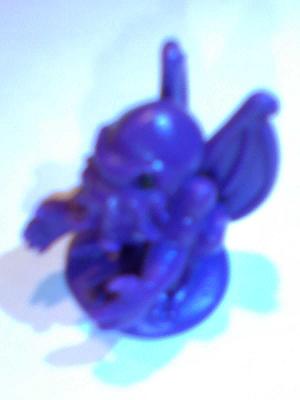 Unspeakable Words is a good choice choice for mixed age groups, as bigger words entail a certain added risk. Also, other than the typical exclusion of proper names, any word in common usage is acceptable. It’s usually pretty easy to find at least one among the seven cards in a hand. I love that the game takes a generally conservative category and adds a bit of attitude. Even the few optional rules fit the Cthulhu theme. Psychotherapy would allow a player to roll against the value of a discarded hand in order to recover a lost pawn. The Unspellable Oath would allow a player with only one pawn to make gibberish words because “unhinged folk can believe anything is a word.”
Unspeakable Words is a good choice choice for mixed age groups, as bigger words entail a certain added risk. Also, other than the typical exclusion of proper names, any word in common usage is acceptable. It’s usually pretty easy to find at least one among the seven cards in a hand. I love that the game takes a generally conservative category and adds a bit of attitude. Even the few optional rules fit the Cthulhu theme. Psychotherapy would allow a player to roll against the value of a discarded hand in order to recover a lost pawn. The Unspellable Oath would allow a player with only one pawn to make gibberish words because “unhinged folk can believe anything is a word.”
We’re having a great time with Unspeakable Words in my family. I’m only a little concerned about what my daughter’s teddy bear is going to do with his army of mini Cthulhus.
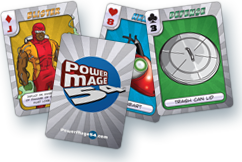 It’s been a bit since we first talked about PowerMage 54, but I’ve finally gotten a chance to play the game. Corey L. Kliewer both designed, and illustrated the game, and has setup a website for it here.
It’s been a bit since we first talked about PowerMage 54, but I’ve finally gotten a chance to play the game. Corey L. Kliewer both designed, and illustrated the game, and has setup a website for it here.
At its most base, the game is a “draw-a-card, choose-an-action” type of game. Each player starts with 5 cards, and 100 hit points. The goal of the game is to get the other player down to 0 hit points.
When you start your turn, you draw a card. You now have several options:
- Attack
- Increase Health
- Use an ability from a Face card, or Thump card
- Pass (if you have 5 or less cards)
Each action is pretty straight forward, and there are some interesting combinations you can use when it comes to Face cards and Thump cards.
The action is fairly fast pace once you get the hang of things, and I was pleasantly surprised by the gameplay. The special actions and Thump cards add some variety into the play, and really make the game interesting. You can speed the game up even more by using a varient where you half your hit points when the deck is reshuffled.
My one complaint about the game? Putting the numbers and suits from a standard deck of cards onto the cards. It somehow cheapens the game. My first thought was “Oh, the designer thought ‘Hey, you may not like my game, but at least you can play any game that requires a standard deck of cards if you don’t’.”
So, PowerMage 54…Should you check it out?
Yes, you should. Corey has created a solid, entertaining game in a small package.
Besides, the game is only $7 from its website.
If you want to check out the rules before you buy, you can find there here.
 I recently wrote about The Dice Turret, an inexpensive, cardboard dice tower.
I recently wrote about The Dice Turret, an inexpensive, cardboard dice tower.
Well since I wrote that article I was contacted by Brian from The Dice Turret and was provided with a free Turret for review.
The Dice Turret comes flat packed in 3 pieces. 1 part makes up the outside of the tower, 1 part makes up the baffles inside the tower, and the last part is the optional dice tray.
The Turret didn’t come with any instructions, but with a label that said to go here for them. Once there I was greeted with an easy to follow video on how to assemble the tower. It took about 5 minutes and I was up and going! Everything just tabs into place and holds pretty tightly.
The cardboard for the Turret is pretty thick and durable, but I’d still be careful with the thing. It doesn’t seem like it would stand up well to multiple set ups and tear downs, so I probably will just leave it assembled and not even bother trying to take it apart.
All that’s well and good, but how well does it work?
Great!
I tossed a handfull of various dice of all different sides and sizes through and they happily rattled their way down into the tray. The tower is sturdy, and doesn’t wobble or anything as the dice go down.
If you’re looking for a good dice tower, but don’t have a lot of cash, then this tower is the perfect thing.
This is actually my first dice tower, and I’m eager to put it through its paces.
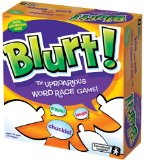 Here’s a brief lowdown on Blurt! before the rest of the review. I brought Blurt! to Thanksgiving dinner with my family. We played Blurt! for 15 minutes, 14 minutes of which we complained about not wanting to play Blurt! anymore.
Here’s a brief lowdown on Blurt! before the rest of the review. I brought Blurt! to Thanksgiving dinner with my family. We played Blurt! for 15 minutes, 14 minutes of which we complained about not wanting to play Blurt! anymore.
Yeah…
The idea behind the game seemed really great. Cards that have definitions on them, and you have to call out the right word to advance your piece. Unfortunately, it’s not pulled off very well.
One player, the reader, rolls the die. Whatever number comes up, you read the definition off a card that corresponds with that number. Who ever calls out the right word first moves the number of spaces rolled on the die. Then the role of the reader passes to the next player. There’s also rules for people who land on the same space as someone else.
Very simple.
The main problem with Blurt is that all the definitions are VERY easy for your average adult. Even the “hard” side of the card wasn’t very hard. There didn’t seem to be any level of difficulty change for higher numbers rolled vs lower numbers rolled. Our game came down to whoever screamed the right word out the loudest would move.
Some people at the table ended up getting a lot of words right, but on rolls of 1 or 2, while other people (at no real increase in difficulty) where moving 5 or 6 spaces at a time.
The game might be better suited to tweens, whose vocabulary may not be up to snuff of that of an adult, but we didn’t run across anything really taxing for even that age range.
Blurt! has potential. With some harder cards, and maybe an extra mechanic or two, it could really be a good party game. As it stands right now, there’s a LOT of better party games out there to spend your money on.
A copy of Blurt! was provided for free to review by Educational Insights.
- Comments Off on Second Look-Blurt!
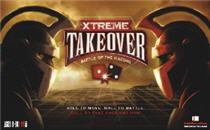 I recently had time to sit down with Curtlin Toys and Games’ Xteme Takeover as Curtis Paul, the designer, was kind enough to send me a copy for review.
I recently had time to sit down with Curtlin Toys and Games’ Xteme Takeover as Curtis Paul, the designer, was kind enough to send me a copy for review.
Let me start of by mentioning the box and board. The box is pretty big, but pretty empty. Inside is a plastic board that is a bit smaller than the box, player pieces, a rulebook, and two dice. The reason the box had to be big is because the plastic board does not fold. It’s one solid piece full of holes for the player pieces to “wedge” into.
The cover of the game looks pretty exciting, but that’s where the visual appeal ends. The board itself is pretty plain. I can’t speak to the quality of the sticker that overlays on the plastic board, or the Xiacon (player pieces) themselves, because I have a production copy, and Curtis points out that these things have changed in the final version of the game.
How does it play? Not very well, in my opinion. There’s a lot of hype on the website and videos for the game, but the game itself unfortunately falls flat. It’s sort of a glorified football without a ball. The goal is to get your Xiacons into the opposing player’s bunker.
You roll two dice to move, and you can take this number and move 1 or more Xiacons. You can move 1 Xiacon the total number of moves, or split the number of moves across multiple Xiacons. Xiacons can battle each other, but their fate is decided by a roll of the die plus a modifier based on the type of Xiacon in the battle. There are also certain “safe zones” on the board where a Xiacon can go and not be engaged in battle.
The whole game seemed VERY based on the die rolls. There’s very little strategy in there, and I found that upgraded Xiacons rarely were defeated by lesser Xiacons in battle. The board is big enough where it’s even possible to avoid many battles and make your way to points at the end of the board that will blow the back of your opponent’s bunker wide open. It’s then easy to just march your pieces right in.
Who might this game actually appeal to? I really don’t know. Older children (maybe 8 – 10 year-olds) might get a kick out of the theme. Anyone who doesn’t mind endlessly rolling 2 dice over and over again may like it also.
The designer compares Xtreme Takeover to all sorts of other popular classic and mass market games, but I really don’t see it. Unfortunately I think the game just isn’t very good, and you’re probably better off spending your money on something better.
A copy of Xtreme Takeover was provided for free to review by Curtlin Toys and Games.
Trending
- Baila, the Estonian Drinking Card Game
- Home
- Scientific Study Concludes: Monopoly Games May Never End
- Dora the Explorer Games
- Oh the Irony—Illuminati Card Game Continues to Inspire Conspiracy Theorists
- CHH Chess Sets
- Game Bandit
- Planescape: Desire and the Dead
- Traveller Deck Plans
- Christian Role Playing Games
Archives
Most Popular Articles
- The 20 Most Valuable Vintage Board Games
- Sequence Game, and Variants
- USPS Adds Board Game Flat Rate Box
- Baila, the Estonian Drinking Card Game
- The 13 Most Popular Dice Games
- The Truth About Dominoes On Sunday in Alabama
- Are Board Games Dangerous?
- Oh the Irony—Illuminati Card Game Continues to Inspire Conspiracy Theorists
- The Convoluted Story of Iron Wind Metals, Ral Partha, and Battletech Miniatures
- What Happened to the Jewel Royale Chess Set?
Recent Posts
- Toy Fair 2019—Breaking Games
- Talisman Kingdom Hearts Edition
- Toy Fair 2019—Winning Moves
- Toy Fair 2019—Games Workshop
- Toy Fair 2019—Star Wars Lightsaber Academy
- Toy Fair 2019—Stranger Things Games
- Toy Fair 2019—HABA
- Licensing Roundup
- Game Bandit
- 2018 A Difficult Year For Hasbro But Not For D&D Or MtG
Recent Comments
- on Toy Fair 2019—Winning Moves
- on Game Bandit
- on Second Look—Dungeons & Dragons Waterdeep Dragon Heist
- on Crowdfunding Highlights
- on Beyblade SlingShock
- on Game Bandit
- on Game Bandit
- on Watch This Game!, the Board Game Review Board Game
- on Second Look—Vampire: The Masquerade 5th Edition
- on Palladium Books Loses Robotech IP License, Cancels Five-Year-Overdue Robotech RPG Tactics Kickstarter




